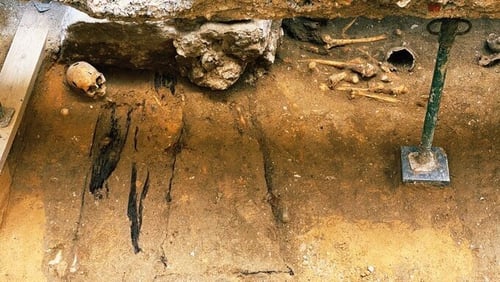
Skull found in dig for Red Hugh O'Donnell's remains
Archaeologists in Spain believe they may have discovered the burial place of 16th Century Irish nobleman Red Hugh O'Donnell.
A dig under way on a street in Valladolid in northwest Spain has revealed the remains of the church where O’Donnell is believed to have been buried.
Yesterday, the mayor of Valladolid Oscar Puente posted images of the excavation work and wrote: "In the chapel of Wonders, in the exact place where Red Hugh O'Donnell is believed to have been buried as well as Christopher Columbus, some remains and two coffins have appeared."
The photographs show a human skull and bones along with what appear to be two wooden coffins.
Earlier this month, Dr Hiram Morgan of University College Cork’s School of History, told RTÉ's News at One that Red Hugh died in Spain in 1602 of natural causes.
He said that Red Hugh, along with his father-in-law Hugh O'Neill, the Earl of Tyrone, fought the Nine Years' War against the English and having sought aid from Spain, their forces were defeated at the Battle of Kinsale in 1602.
Red Hugh then travelled to Spain to ask the king, Philip III, to send another army to Ireland.
He was on his way to Valladolid, which was the capital of Spain at that time, when he died.
He was buried in the chapel of the Franciscan monastery in the city.
This was the same church where Christopher Columbus was buried in 1506. His remains were later moved, but archaeologists believe the coffin he was originally buried in, is one of two found during the excavations.
Dr Morgan said there are stories that Red Hugh was poisoned by a Galway merchant called James Blake, who has been described as a "double agent", but there is no evidence to support this.
He said Spanish records show that Red Hugh had been suffering from a fever for more than two weeks before he died.
Dr Morgan said one way that he may be identified is that he had both his big toes amputated as a result of frostbite he sustained while hiding out in the Dublin mountains in 1592 following his escape from four years of captivity at Dublin Castle.
The Valladolid culture and tourism ministry said on twitter that the "right wall of the Chapel of Wonders has been confirmed".